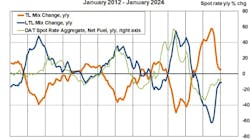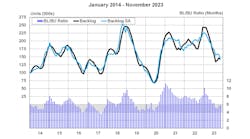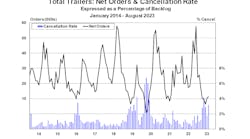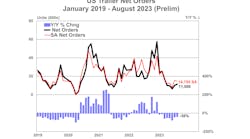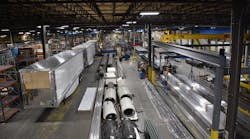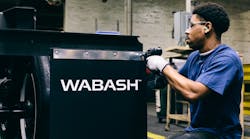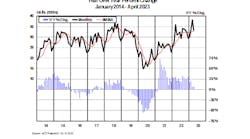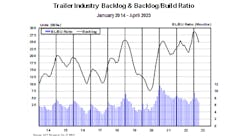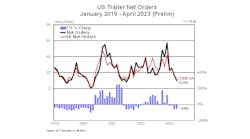NATIONAL Truck Equipment Association (NTEA) market data and research director Steve Latin-Kasper doesn't sugar-coat it: This recession, he says, is the worst since World War II, and it has damaged the industry.
But he says the encouraging thing is the way the industry has dealt with it.
“The big difference in this recession is that the huge majority of companies in the commercial truck industry have dealt with it — managed it and planned for it — better than they did in 1980-82,” he said in his Truck Equipment Market Outlook at the Business and Market Planning Summit September 21 in Dearborn, Michigan. “There have been very few bankruptcies in the commercial truck industry over the last three years. So as bad as it's been, they've survived this well.”
He said that trucks and truck chassis have “borne the brunt” of the downturn. After peaking in 2006, accounting for $90 billion of the total industry, that segment has fallen to $65.8 billion in 2007 and $49.7 billion in 2008, and is projected to account for $27.8 billion in 2009. The slide in 2009 is expected to be 44% — nearly twice that of truck-equipment shipments (23.7%).
Between June 2008 and June 2009, the fall was steepest in Class 5 (63.3%) and Class 6 (58.7%).
Latin-Kasper said production will continue to fall in Classes 3-7 through the rest of the year, and we won't see a rise until the second quarter of next year. He said medium-duty production has been tied very closely to consumer expenditures since 1992, and when consumers start spending, truck production will increase.
Production of heavy-duty trucks experienced “kind of a strange blip” in 2008 that caused it to stabilize briefly rather than continue in a straight line down. This year has not been good, but he says it's “beginning to stabilize.”
He said most forecasts for trailer production indicate that it will continue to fall for the rest of this year and probably won't see an increase until the third quarter of 2010 because of “inventory being held.”
“Inventories aren't being held by us — they're being held by customers,” he said. “They have all the trucks and trailers they need for the foreseeable future. Which is why those of you who have been holding up well since the second half of 2008 have been making it on repairs, maintenance, service, and replacement parts.”
After rallying in 2008, state and local government spending on equipment had plunged 12% compared to business truck production by the middle of this year, and he said it will continue to go down because of “massively declining tax revenues from the last few quarters of 2009, slowing their ability to spend in 2010.” However, he sees state and local government construction spending increasing next year. By the second half of next year, he sees private construction providing more opportunities.
He sounded a warning regarding the price of steel and steel products: After falling dramatically between July 2008 and April of this year, the cost of carbon steel scrap and stainless/alloy steel scrap went up 47.2% and 46.1% respectively in the second quarter of this year.
“Scrap markets lead new-product markets,” he said. “They will always take off before actual steel suppliers shipping out of warehouses start increasing their prices. Now would be a good time to buy steel. Prices aren't going to go back down.”
Although the price of a gallon of diesel fuel is manageable right now ($2.60), Latin-Kasper said it will increase significantly in the next two to three years, perhaps reaching or exceeding the all-time high of $4.76 set in July 2008.
“Customers who are driving trucks are going to be seriously re-thinking what for them is one of the biggest cost factors, and how they're going to deal with it,” he said. “The question for you becomes: ‘How am I going to help my customers deal with one of their biggest cost headaches?’ Anything you can do to help them cut their fuel costs is going to make you their preferred supplier.”
Money from Mexico
He said that for the first time, Mexico became the United States' top source outside of the US for commercial trucks and equipment. In 2008, US imported $8.2 billion worth of goods from Mexico, compared to $5.1 billion from Canada.
“New ventures are likely to take place in Mexico, rather than Canada,” he said. “There are some opportunities there.”
Canada will remain this country's top destination for exports, accounting for more than half of total exports and nearly 10 times that of the next-highest country, Mexico. But that market has fallen 45.7% since 2006, while Eastern Europe (up 79.2%), Taiwan (up 73.2%) and Brazil (up 15.2%) have experienced huge upticks.
“It's never wrong to diversify,” he said. “One of the ways you can make that happen is geographic. There are opportunities out there.”
Positive outlook
Latin-Kasper's forecast pros are moderate interest rates, the yield curve, inflation, housing starts, productivity, and the completion of emissions changes. His forecast cons are terrorism/confidence, federal budget deficits, capital expenditures, unemployment, real income, state and local revenues, and decreasing trade.
“Regardless of how slow business gets in 2009, hold on to critical personnel,” he said. “Use the slow time for training, plant maintenance, and corporate planning.
“Keep a tight rein on inventories though the rest of 2009 and first half of 2010. Be ready to ramp up production in the second half of 2010. Have the people and materials in place, ready to go.”
TRUCK INDUSTRY MARKET FORECAST
Presenter: Ken Kremar, Principal, Industry Practices Group, Global Insight Inc
He said the global and US recessions are ending.
“Leading indicators are improving across regions and the global inventory correction is winding down,” he said. “Massive and unorthodox US and foreign monetary stimulus promoted growth. Financial markets have stabilized, though credit remains tight. The timing and speed of the recovery will vary, with Asia leading, the US coincident, and Europe lagging
“US economic activity is beginning a slow recovery, with housing and autos leading the upturn. Employment growth will resume next spring. Consumers will remain cautious. Wage and price inflation will remain subdued for several years. The bottom line is this: a deep recession in 2009, modest recovery in 2010, and a stronger rebound in 2011-2012.”
Kremar said supply managers' indexes have turned up, industrial materials prices are recovering, payroll employment has experienced a steep decline, consumer sentiment is still in a recession zone, and a stock market rally is under way.
He said deflation fears have eased, and inflation fears are overblown.
“Rising commodity prices have eased fears of deflation,” he said. “Oil prices have moved higher, but remain well below year-ago levels. Natural gas prices have weakened in the face of weak demand and increasing supply. Core inflation remains tame, despite increases in commodity prices. There is excess capacity in product and labor markets. Wage inflation in the private sector has almost disappeared.
“The Fed will maintain a relatively aggressive posture on policy. The bottom line is that the economy is at a critical turning point. Improved financial conditions, a stabilized housing market, steadier consumer spending, and reduced inventory slashing are encouraging signs for economic growth. Nevertheless, tight credit conditions, a weak labor market, and sluggish income growth continue to constrain economic activity. With the unemployment rate anticipated to stay high through 2010, the Fed is confident that wage and price inflation will remain subdued in the foreseeable future.”
He said cross-currents are affecting consumer finances. The positive forces: low energy prices, fiscal stimulus, and a stock-price rally. The negative forces: job losses, declining housing wealth, stock-market losses, tight credit, high debt burdens, and a low saving rate.
He said sales of trucks into the construction market will remain weak until 2011, with real construction spending down 15% this year and 2% in 2010, then finally increasing 11% in 2011. He said the increases next year will be led by residential (10.8), highways and streets (6.8%), and public education (5.6%).
“The inventory correction in traditional manufacturing is just about over and demand is slowly improving,” he said. “Weakness in nonresidential construction will remain a problem for some, with wholesale and distributor activity down 10% this year.”
The trucking industry has been hit hard by the recession, he said, with the ATA Truck Tonnage Index plunging nearly 15% in the second half of 2008. In the first half of 2009, everything was down: TL loads (20%), TL revenue (34%), LTL tonnage (22%), and LTL revenue (35%).
“Trucking company equipment utilization rates have a big hole to climb out of,” he said. “Trucking companies will benefit from a recovering economy. Profit margins will improve slowly.”
He said the truck market will experience a weak recovery next year.
“There will be a slow recovery in the economy, motor carrier traffic, and end-market activity,” he said, “along with modest improvement in profits amid tight credit conditions. There is a lot of idle and underutilized capacity.
“With the higher price of 2010MY trucks ($5,000-$10,000) surcharge due to cost of meeting EPA 2010, some buyers will want to wait and see how the new technology performs.”
He said the market will snap back from 2011-2014.
“The economic recovery will hit its stride, with GDP growth averaging 3% annually,” he said. “Profits will rebound and credit conditions will ease. Equipment utilization rates will tighten. Replacement pressures will mount, with more aggressive and successful fleets expanding capacity.”
His conclusions:
-
The bottom of the recession was probably in June.
-
We do not see employment rising until 2010.
-
We still do not see a V-shaped recovery, since credit conditions will stay tight and the consumer will remain cautious.
-
Inflation remains a risk for the future, but not an imminent threat.
-
Truck buyers will re-enter the market slowly, waiting to see solid evidence of recovery in their rear-view mirrors before taking the plunge.
ECONOMIC & TRUCKING INDUSTRY UPDATE
Presenter: Bob Costello, chief economist & vice president, American Trucking Associations
His macroeconomic summary:
-
Recent revisions to GDP data confirm the recession was the longest and deepest in post-war history.
-
Overall economic activity bottomed out mid-year.
-
Growth is expected during the second half of the year.
-
Recoveries after a financial crisis are usually slow.
-
U-shaped recovery still seems most likely, after 3rd quarter blip.
-
Recent revisions to the GDP data indicate the recession was much deeper than previously thought, but growth will resume this quarter.
Costello said truck capacity will tighten significantly once a recovery commences and any excess trucks are worked back into the fleet — currently 5% of the fleet is parked.
He said trucking failures are surprisingly low — in terms of fleets with more than five trucks, there were about 20% as many in the first two quarters of this year as there were in the first two quarters of 2008 — but truck counts are more important than the number of carriers that fail.
He said fleets continue to downsize — 8.5% in the last nine quarters, and 4.7% between June 2008 and June 2008. (That number includes the fleet size only for those that are surviving.) He said truck sales are running well below historical replacement rates, with no significant pre-buy.
Average miles per truck have decreased nearly 25% this year and have gone down every year since 2005.
“More truck capacity has been taken out of the industry than you might think — it is just being masked by the large drop in demand, for now,” he said.
INDUSTRIAL MARKETS OUTLOOK
Presenter: Eli S. Lustgarten, senior VP, Longbow Securities
He said a 2010 pre-buy is unlikely, noting that companies buy trucks to move freight, and a pre-buy is unnecessary because you don't move freight in a recession.
“The weak economy will keep freight demand soft for most of the year,” he said. “Current equipment is in good condition, though the average fleet age is creeping up at 6.2 years. But age doesn't matter if you are not moving freight. There is plenty of capacity available; used truck prices are very weak. Used capacity is coming to market as companies fail; the current failure rate is 1000 companies per quarter, freeing 40,000 trucks. There are potentially more favorable economics for 2010 engines compared to 2007 if the increase in fuel economy is correct.
He said 2010 truck prices are going up, led by Volvo ($9600), Daimler-Benz with Cummins engines ($6700 to $7300) and with Detroit Diesel Big Bore ($9000), and Navistar ($6000 for MaxxForce 7, DT, 9 10, and $8000 for MaxxForce 11,13).
Lustgarten said strong Mexico and export sales in 2008 will wane. Mexico had new emissions in mid-2008, and exports were affected by a strengthening dollar and global economic slowing.
“The stimulus bill has had a minor effect on the sector,” he said. “Bonus depreciation may help if the potential $8000 to $10,000 increase in 2010 truck prices is real and holds. Credit availability could limit the ability to pre-buy trucks. The drop in freight movement causes truck capacity utilization to drop below 75%, compared to a longer-term average of about 88%. That implies there is an excess of 200,000 to 250,000 trucks. A slow economic recovery could even hurt 2010 truck demand.”
A heavy trucks survey showed that:
-
Pricing remains weak. Reports about the future direction of rates were mixed, possibly the early signs of stabilization, which include a modest improvement in rates excluding fuel surcharges (down 64% in July from 72% in June).
-
Purchasing intentions remains weak. The majority of contacts believe that more normal purchasing activity will occur in 2011 at the earliest. There was a modest uptick to 21% from 12% of respondents considering purchases to beta test the new engines and/or take advantage of deals/trade-ins/tax credits that may exist.
He said field reports indicate an inventory build-up planned for the second half of this year.
“We are hearing reports in the field that OEM engine suppliers and truck manufacturers are planning to build some inventory in the second half of 2009, despite ongoing weak industry conditions and an uncertain outlook,” he said. “The potential higher production reflects several factors, including pushing the envelope on carryover of 2009 product into 2010 because of the higher prices for 2010-compliant product: first-half 2009 Class 8 NAFTA truck production is estimated at 53,000 units — 28,500 in the first quarter and 24,800 in the second; production in the second half of this year may be as high as 60,000 units-around 29,000 in the third quarter and perhaps 31,000 in the fourth.
“Second-half 2009 production volumes for the sector may be up by as much 10% to 13% for component suppliers, as well as truck producers and even more for engine producers. The downside is that the increased second-half volume may be borrowing from first-half 2010 production. More importantly, the data reinforces our position that Class 8 truck volumes will not return toward more normal levels until 2011 at the earliest.”
The economic outlook for the U.S. economy deteriorated dramatically as 2008 came to a close under the pressure of a global credit crunch and the volatility of commodity prices and currencies.
Lustgarten said the downturn is affecting virtually every region of the world.
The absence of credit and the failure of financial institutions quickly dragged the industrial sector into full-fledged recession. Domestic manufacturing activity plummeted as industrial production turned sharply negative. Capacity utilization dropped dramatically to the mid-60s. The ISM PMI fell sharply to levels of clear contraction from 43.5 in September 2008, bottoming at 32.9 in December, before gradually recovery to 35.6 in January 2009, rising gradually to 40.1 in April, 42.8 in May, 44.8 in June, 48.9 in July, and 52.9 in August.
More important, the global economy and export outlook sharply deteriorated. The European PMI plummeted from 45 in September 2008, bottoming at 33.5 in February 2009 before gradually recovering to 41.1 in April, 43.9 in May, 44.8 in June, 46.3 in July, and 47.9 in August.
China also slowed markedly in late 2008, but was the first to show signs of recovery to growth (over 50 since April 2009), reflecting its focused stimulus program.
The dollar strengthened about 20% versus the Euro and 16% on a trade-weighted basis.
He said early signposts for the end of the recession have been met:
-
US housing data has begun to flatten and/or improve — new home sales, starts.
-
Global purchasing manager indexes have begun to rise.
-
Financial risk metrics have begun to normalize.
-
Commodity prices have stabilized and/or begun to rise.
-
Global equity markets have improved; financial markets have stabilized.
He said economic recovery is born of a combination of government policy efforts, such as:
-
Stimulus packages recently passed by Obama Administration (deficit spending).
-
The economy's built-in recuperative powers.
He said the new, more normal level of demand for 2011-2012 is perceived to be lower than the end-market demand realized in 2006-2008.
“We are unlikely to return quickly to 16 to 17 million car sales that prevailed from 1999-2005 — perhaps 11 million to 12.5 million is the new norm,” he said. “Housing is unlikely to return quickly to two million starts; the new norm may be 1.3 to 1.6 million over the next few years, with cautious funding keeping starts below one million at least into 2011.
“The truck market is likely to return to more normal levels of demand as early as 2011 — Class 8 trucks in the 175,000 to 225,000 range. Prior level peaks of over 300,000 are unlikely until at least the next emission cycle. Construction and mining, engines and turbines, railcars and other heavy equipment face a slow recovery through 2012 to levels likely below 2006 to 2008.
“Farm equipment end-market demand growth is dependent on global economic growth, global demand and weather. Growth could resume as early as 2011. Construction equipment end-market demand in 2010 looks relatively flat to up modestly. Production will increase 15% to 20% or more due to the end of inventory liquidation, which will allow OEMs to produce at or near retail demand. The upturn will favor smaller to medium equipment (more units, less dollars), which has been declining for the past three to four years.
“Equipment for rental companies will likely see an upturn in demand as contractors may favor rental rather than outright purchases. Heavy-equipment demand will likely be soft, declining 10% or more in 2010.”
He said crane sales remained strong for large cranes, with sales up 15%-plus in 2008. AWP sales held up to the first quarter of 2008, but have plummeted since. Boom and scissor lift sales fell 15% to 20% in 2008, reflecting uncertain credit availability and weak capital spending by rental companies. Tele-handlers have been down 20% to 25% since 2007. Industrial lift trucks sales were off 20% in 2008 and more in 2009.
“Most material handling segments will be down sharply in 2009,” he said. “Cranes will decline about 30% to 40% in 2009 and a further 35% to 40% in 2010.”
